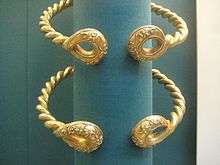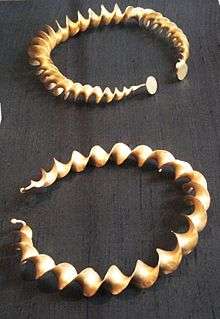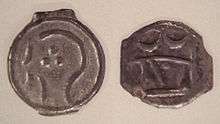List of Iron Age hoards in Great Britain
The list of Iron Age hoards in Britain comprises significant archaeological hoards of coins, jewellery, precious and scrap metal objects and other valuable items discovered in Great Britain (England, Scotland and Wales) that are associated with the British Iron Age, approximately 8th century BC to the 1st century AD. It includes both hoards that were buried with the intention of retrieval at a later date (personal hoards, founder's hoards, merchant's hoards, and hoards of loot), and also hoards of votive offerings which were not intended to be recovered at a later date, but excludes grave goods and single items found in isolation. Hoards of Celtic coins dating from the time of the Roman occupation of Britain are also included here.
List of hoards
| Hoard | Image | Date | Place of discovery | Year of discovery | Current Location | Contents |
|---|---|---|---|---|---|---|
| Alton Hoard |  |
mid 1st century AD | Alton, Hampshire 51°08′56″N 0°58′37″W / 51.149°N 0.977°W |
1996 | British Museum, London | 50 gold staters of Commios, Tincomarus and Epillus (Hoard A) 206 gold staters of Tincomarus and Verica (Hoard B) 1 Roman gold ring 1 Roman gold bracelet[1][2] |
| Beaminster Hoard | early 1st century | Beaminster, Dorset 50°48′32″N 2°44′24″W / 50.809°N 2.740°W |
2003 | Dorset County Museum, Dorchester | 160 silver staters[3] | |
| Beverley Hoard |  |
mid 1st century BC | Beverley, East Yorkshire 53°50′42″N 0°25′37″W / 53.845°N 0.427°W |
1999–2007 | Hull Museums Collections British Museum, London |
110 gold staters[4][5] |
| Cheriton Hoard | 80 to 60 BC | Cheriton, Hampshire 51°03′09″N 1°10′13″W / 51.05245°N 1.170325°W |
1984 | British Museum, London | 50 gold staters[6] | |
| Chute Forest Hoard | 80 to 60 BC | Chute Forest, Wiltshire 51°15′57″N 1°33′23″W / 51.265865°N 1.556348°W |
1927 | British Museum, London | 36 gold staters[7] | |
| Clacton Hoard | 80 to 60 BC | Clacton-on-Sea, Essex 51°47′31″N 1°08′46″E / 51.79197°N 1.145973°E |
1898 | British Museum, London | 76 gold staters[8] | |
| Climping Hoard | mid 1st century BC | Climping, West Sussex 50°48′47″N 0°34′41″W / 50.813°N 0.578°W |
2000 | British Museum, London | 18 gold staters[note 1][10] | |
| Dovedale Hoard | 1st century BC | Reynard's Cave and Kitchen, Dovedale, Derbyshire 53°04′11″N 1°47′05″W / 53.0696°N 1.7848°W |
2014 | Buxton Museum and Art Gallery | 26 gold and silver coins, including three pre-conquest Roman coins, and 20 Late Iron Age gold and silver coins belonging to the Corieltauvi tribe[11] | |
| Essendon Hoard | 60 BC to 20 BC | Essendon, Hertfordshire 51°45′46″N 0°09′11″W / 51.762913°N 0.153169°W |
1992 | British Museum, London | 257 gold coins, 7 swords, 4 spearheads, a dagger and a decorated sheet of bronze that may have faced a wooden shield, various ingots and segments of a gold torc[12] | |
| Farmborough Hoard |  |
early 1st century | Farmborough, Somerset 51°20′35″N 2°29′02″W / 51.343°N 2.484°W |
1984 | British Museum, London | 61 gold staters[13] |
| Field Baulk Hoard | mid 1st century | Field Baulk, March, Cambridgeshire 52°32′20″N 0°05′13″E / 52.539°N 0.087°E |
1982 | British Museum, London | 872 silver coins minted by the Iceni tribe, in a round pot[14] | |
| Great Leighs Hoard | mid 1st century BC | Great Leighs, Essex 51°49′37″N 0°30′22″E / 51.827°N 0.506°E |
1998–1999 | Chelmsford Museums | 40 gold staters[15] | |
| Hallaton Treasure |  |
1st century AD | Hallaton, Leicestershire 52°33′00″N 0°50′00″W / 52.550°N 0.8333°W |
2000 | Harborough Museum | 5,000 silver and gold coins a silver gilt Roman parade helmet jewellery[16] |
| Honingham Hoard | mid 1st century AD | Honingham, Norfolk 52°39′47″N 1°06′29″E / 52.663°N 1.108°E |
1954 | Norwich Castle Museum and Art Gallery | 341 Iceni silver coins[17] | |
| Ipswich Hoard |  |
1st century BC | Ipswich, Suffolk 52°03′32″N 1°09′22″E / 52.059°N 1.156°E |
1968–1969 | British Museum, London | 6 gold twisted torcs[18] |
| Kimbolton Hoard | mid 1st century BC | Kimbolton, Cambridgeshire 52°18′29″N 0°24′25″W / 52.308°N 0.407°W |
2010 | 67 gold staters and one gold quarter-stater[19] | ||
| Langstone Hoard |  |
mid 1st century AD | Ringland, Newport 51°36′36″N 2°53′53″W / 51.610°N 2.898°W |
2007 | 2 bronze bowls and a bronze wine strainer[20] | |
| Little Horwood Hoard | 1st century BC | Little Horwood, Aylesbury Vale, Buckinghamshire 51°58′05″N 0°51′00″W / 51.968°N 0.850°W |
2006–2007 | Buckinghamshire County Museum, Aylesbury | 75 staters found over an 11-month period which are said to be part of the Whaddon Chase Hoard[21][22][23] | |
| Llyn Cerrig Bach Hoard |  |
4th century BC to 1st century AD | Llyn Cerrig Bach, near Valley, Anglesey 53°15′32″N 4°32′24″W / 53.259°N 4.540°W |
1942 | National Museum Cardiff | votive objects deposited over a period of several hundred years, comprising over 150 items of bronze and iron, including 7 swords, 6 spearheads, fragments of a shield, part of a bronze trumpet, 2 gang chains, fragments of iron wagon tyres and horse gear, blacksmith's tools, fragments of two cauldrons, and iron bars[24] |
| Llyn Fawr Hoard | 8th to 7th century BC | Llyn Fawr Lake, Rhigos, Glamorgan 51°43′12″N 3°34′05″W / 51.720°N 3.568°W |
1909–1913 | National Museum Cardiff | bronze cauldron, a number of chisels, sickles and socketed axes, a sword, a spearhead, a razor, and horse harness equipment[25] | |
| Lochar Moss Hoard | 50 to 200 AD | Lochar Moss, near Dumfries, Dumfries and Galloway 55°05′09″N 3°34′50″W / 55.0858829°N 3.5806428°W |
1840s | British Museum, London | brass torc and bronze bowl[26] | |
| North Foreland Hoard | early 1st century BC | North Foreland, Kent 51°22′30″N 1°26′42″E / 51.375°N 1.445°E |
1999 | Powell-Cotton Museum, Birchington-on-Sea | 63 potin (a bronze alloy with high tin content) coins[27] | |
| Peatling Magna Hoard | mid 1st century BC | Peatling Magna, near Market Harborough Leicestershire 52°31′41″N 1°07′37″W / 52.528°N 1.127°W |
2012 | Harborough Museum | 10 gold staters minted in northern France or the Low Countries[28] | |
| Polden Hill Hoard | 50 AD to 100 AD | Polden Hill, Somerset 51°09′38″N 2°55′26″W / 51.160549°N 2.923972°W |
1800 | British Museum, London | about 90 metal artefacts including horse gear and trappings, segments of 3 shields, 6 brooches, 3 bracelets, parts of 2 torcs[29] | |
| Salisbury Hoard | 3rd century BC[note 2] | Netherhampton, near Salisbury, Wiltshire 51°04′26″N 1°47′38″W / 51.074°N 1.794°W |
1988 | British Museum, London | over 600 objects, mostly miniature bronze versions of shields, tools, daggers and spearheads[30] | |
| Scole Hoard | mid 1st century BC | Scole, Norfolk 52°21′50″N 1°09′22″E / 52.364°N 1.156°E |
1982–1983 | 202 Iceni silver coins and 87 Roman coins[31] | ||
| Sedgeford Hoard |  |
1st century BC | Sedgeford, Norfolk 52°54′N 0°33′W / 52.90°N 0.55°W |
2003 | King's Lynn Museum | 39 Gallo-Belgic gold staters, concealed inside a cowbone[32] |
| Shalfleet Hoard | .jpg) |
late 1st century BC to early 1st century AD | Shalfleet, Isle of Wight 50°42′04″N 1°27′29″W / 50.701°N 1.458°W |
2009 | Sold at Bonhams, 2011.[33] | four large bowl-shaped silver ingots, six small silver fragments and one gold British B (or "Chute") stater of Late Iron Age date.[34] |
| Silsden Hoard | mid 1st century AD | Silsden, West Yorkshire 53°54′50″N 1°56′13″W / 53.914°N 1.937°W |
1998 | Cliffe Castle Museum, Keighley | 27 gold coins and a finger ring[35] | |
| Snettisham Hoard |  |
mid 1st century BC | Ken Hill, near Snettisham, Norfolk 52°53′06″N 0°29′20″E / 52.885°N 0.489°E |
1948–1973 | British Museum, London Norwich Castle Museum |
over 150 gold torc fragments (over 70 of which form complete torcs), and various objects made of metal and jet[36] |
| Southend Hoard | 60-50 BC | Southend-on-Sea, Essex 51°32′18″N 0°42′52″E / 51.53832°N 0.714513°E |
1986 | British Museum, London | pottery sherds and 33 gold staters[37] | |
| South Norfolk Hoard |  |
late 1st century BC | South Norfolk | 2012–2013 | Norwich Castle Museum and Art Gallery | 44 'Norfolk Wolf' debased gold staters[38][39] |
| South Wight Hoard | late 1st century BC to early 1st century AD | South Wight, Isle of Wight 50°36′00″N 1°12′00″W / 50.600°N 1.200°W |
2004 | British Museum, London | 18 gold staters, 138 silver staters, 1 thin silver coin, 7 copper alloy coins of the Roman period, 2 bowl shaped silver ingots, 1 bowl shaped copper alloy ingot, 5 sherds of Iron Age pottery [40][41] | |
| Stanwick Hoard |  |
50 BC to 100 AD | Stanwick, North Yorkshire 54°30′24″N 1°43′32″W / 54.506627°N 1.725548°W |
1843 | British Museum, London | about 180 metal artefacts including four sets of horse harnesses for chariots and a bronze horse head [42] |
| Stirling Hoard |  |
3rd to 1st century BC | Near Blair Drummond, Stirlingshire 56°10′01″N 4°02′38″W / 56.167°N 4.044°W |
2009 | National Museum of Scotland, Edinburgh | 4 gold torcs[43] |
| Stonea Hoard | 20-50 AD | Stonea, Cambridgeshire 52°31′12″N 0°08′35″E / 52.519927°N 0.14303°E |
1983 | British Museum, London | pottery beaker and over 850 silver coins[44] | |
| Sunbury Hoard |  |
2nd century BC | Sunbury-on-Thames, Surrey 51°25′19″N 0°25′08″W / 51.422°N 0.419°W |
1950 | Museum of London, London | 317 tin alloy coins and 56 fragments, together with fragments of a pottery vessel[45] |
| Syngenta Hoard[note 3] | mid 1st century BC | Jealott's Hill, near Bracknell, Berkshire 51°27′22″N 0°44′53″W / 51.456°N 0.748°W |
1998 | Reading Museum | 58 gold coins[46] | |
| Tal-y-Llyn Hoard | 1st century AD | near Tal-y-llyn Lake, Cadair Idris, Merionethshire 52°40′19″N 3°53′49″W / 52.672°N 3.897°W |
1963 | National Museum Cardiff | 1 brass plaque, fragments from two brass shields, several decorated brass plates (possibly from a ceremonial cart), and part of a Roman lock[47] | |
| Whaddon Chase Hoard | 1st century BC | near Whaddon, Aylesbury Vale, Buckinghamshire 52°00′00″N 0°49′41″W / 52.000°N 0.828°W |
1849 & 2006 | British Museum, London[48] Buckinghamshire County Museum, Aylesbury | between 450[49] and 800[50] and 2,000 gold staters[21] — see also Little Horwood Hoard | |
| Whitchurch Hoard | _gold_stater_(obverse).jpg) |
1st century BC | Whitchurch, Hampshire 51°13′44″N 1°20′06″W / 51.229°N 1.335°W |
1987 | Hampshire Museums Service (4 of each type). The remainder sold at Christies, October 1988, lots 236-246. | 34 Gallo-Belgic E gold staters, and 108 British B (or, Chute,) gold staters.[51] |
| Wickham Market Hoard |  |
late 1st century BC to early 1st century AD | Wickham Market, Suffolk 52°09′00″N 1°22′01″E / 52.150°N 1.367°E |
2008 | Ipswich Museum | 840 gold staters[52][53] |
| Winchester Hoard |  |
1st century BC | near Winchester, Hampshire 51°03′47″N 1°18′29″W / 51.063°N 1.308°W |
2000 | British Museum, London | 4 gold brooches 1 gold chain 1 gold bracelet (complete) 2 gold bracelet halves 2 gold torcs[54] |
| Walkington Hoard |  |
1st century BC | Walkington, East Yorkshire 53°49′14″N 0°29′17″W / 53.820636°N 0.487977°W |
2005 | Yorkshire Museum, York | a collection of gold staters of the Corieltauvi. Various types of coin. Discovered in batches but regarded as associated.[55][56] |
See also
| Wikimedia Commons has media related to Iron Age hoards. |
Notes
- ↑ A previously unknown type of stater was found which henceforth became known as the "Climping type". It is thought that there was more to the hoard, but it had become dispersed.[9]
- ↑ Although buried in the Iron Age, some of the objects in the Salisbury Hoard are dateable to the early Bronze Age (circa 2400 BC), and may have been recovered from a Bronze Age hoard.
- ↑ The Syngenta Hoard is named after the company on whose land the hoard was found.
Footnotes
- ↑ "Alton hoard of Iron Age coins & jewellery". Art Fund. Retrieved 2010-10-04.
- ↑ British Museum Collection
- ↑ Gannon, Voden-Decker & Bland 2004b, pp. 151, 183
- ↑ Bland 2000, p. 100
- ↑ "Celtic Gold". Hull City Council. Retrieved 2010-07-29.
- ↑ British Museum Collection
- ↑ British Museum Collection
- ↑ British Museum Collection
- ↑ Gannon, Voden-Decker & Bland 2004b, p. 7
- ↑ Bland & Voden-Decker 2002, pp. 106–107, 133
- ↑ "Dovedale Roman and Iron Age coins found after 2,000 years". BBC News. 7 July 2014. Retrieved 2014-07-07.
- ↑ British Museum Collection
- ↑ "coin". British Museum. Retrieved 2010-10-04.
- ↑ "Hoard of Iceni silver coins". British Museum. Retrieved 2012-07-16.
- ↑ Bland 2000, pp. 98–99
- ↑ "The Hallaton Treasure". Harborough Museum. Retrieved 2010-07-14.
- ↑ "Coin hoard from Honingham". Norwich Castle Museum and Art Gallery. Retrieved 2010-07-27.
- ↑ British Museum Collection
- ↑ "Iron Age gold coins discovered in Kimbolton". Hunts Post. 6 October 2011. Retrieved 2011-10-14.
- ↑ "Record ID: NMGW-9C0216". Portable Antiquities Scheme. 23 January 2009. Retrieved 2012-07-19.
- 1 2 Barton & Hitchcock 2008, p. 184
- ↑ Lewis 2009, p. 87
- ↑ "Little Horwood Hoard by Iron Age". The Art Fund. Retrieved 2010-07-29.
- ↑ "Artefacts from Llyn Cerrig Bach". National Museum Wales. Retrieved 2010-08-06.
- ↑ "Cauldron from Llyn Fawr". National Museum Wales. Retrieved 2010-08-06.
- ↑ British Museum Collection
- ↑ Bland 2000, p. 98
- ↑ "Hoard of Celtic coins found in Leicestershire". BBC News. 13 July 2012. Retrieved 2012-07-16.
- ↑ British Museum Collection
- ↑ "The Salisbury Hoard". British Museum. Retrieved 2010-07-14.
- ↑ Hutcheson, Natasha C. G. (2004). Later Iron Age Norfolk: Metalwork, Landscape and Society. Archaeopress. p. 105. ISBN 9781841715827. Retrieved 2013-09-22.
- ↑ "Record ID: PAS-B1F065". Portable Antiquities Scheme. Retrieved 2012-07-19.
- ↑ Bonhams, Antiquities, 13 April 2011, lot 248
- ↑ Leins, Ian; Joy, Jody; Basford, Frank , Portable Antiquities Scheme, Record ID: IOW-EAAFE2. Retrieved 21 November 2013
- ↑ Bland 2000, pp. 103–104
- ↑ "The Snettisham Hoard". British Museum. Retrieved 2010-07-14.
- ↑ British Museum Collection
- ↑ "Norfolk wolf coins unearthed in treasure find". BBC News. 17 April 2014. Retrieved 17 April 2014.
- ↑ "Coin Hoard NMS-397D42". Portable Antiquities Scheme. 26 November 2012. Retrieved 17 April 2014.
- ↑ Williams, Jonathan; Hill, J.D., Portable Antiquities Scheme, Record ID: IOW-38B400. Retrieved 21 November 2013
- ↑ , The Art Fund, The Isle of Wight Ingot Hoard
- ↑ British Museum Collection
- ↑ "First Pictures of Stirling Iron Age Gold Hoard Treasure". Heritage Key. 11 April 2010. Retrieved 2010-07-14.
- ↑ British Museum Collection
- ↑ Linecar, Howard (1949–1951). "On a find of early British tin coins at Sunbury-on-Thames" (PDF). British Numismatic Journal. 26: 339–340.
- ↑ "Syngenta Coin Hoard" (PDF). Reading Museum. Archived from the original (PDF) on 24 July 2011. Retrieved 2010-07-18.
- ↑ "Tal-y-Llyn Plaque". National Museum Wales. Retrieved 2010-08-06.
- ↑ British Museum Collection
- ↑ Barton & Hitchcock 2008, pp. 95, 123
- ↑ "Huge Iron Age haul of coins found". BBC. 17 January 2009. Retrieved 2010-07-19.
- ↑ Burnett, A.M.; Cowell, M.R. , British Numismatic Journal, 1988, Vol.58, p.6ff. Retrieved 21 November 2013
- ↑ "Iron Age coins declared treasure". BBC. 3 July 2009. Retrieved 2010-07-19.
- ↑ "Iron Age gold hoard saved for Ipswich Museum". The Art Fund. 21 June 2011. Retrieved 2011-06-21.
- ↑ Bland & Voden-Decker 2002, pp. 16–18
- ↑ Griffiths, Rebecca. "COIN HOARD: YORYM-E42AA8". Portable Antiquities Scheme. The British Museum. Retrieved 30 March 2015.
- ↑ Woods, Andrew. "Yorkshire Hoards - Prehistoric Wealth". Google Cultural Institute. Google / York Museums Trust. Retrieved 30 March 2015.
References
- Barton, Caroline; Hitchcock, Fi, eds. (2008). Treasure Annual Report 2005/6 (PDF). Department for Culture, Media and Sport.
- Bland, Roger, ed. (2000). Treasure Annual Report 1998 - 1999 (PDF). Department for Culture, Media and Sport.
- Bland, Roger; Voden-Decker, Lisa, eds. (2002). Treasure Annual Report 2000 (PDF). Department for Culture, Media and Sport.
- Bland, Roger; Voden-Decker, Lisa, eds. (2003). Treasure Annual Report 2001 (PDF). Department for Culture, Media and Sport.
- Gannon, Anna; Voden-Decker, Lisa; Bland, Roger, eds. (2004a). Treasure Annual Report 2002 (PDF). Department for Culture, Media and Sport.
- Gannon, Anna; Voden-Decker, Lisa; Bland, Roger, eds. (2004b). Treasure Annual Report 2003 (PDF). Department for Culture, Media and Sport.
- Hitchcock, Fi, ed. (2006). Treasure Annual Report 2004 (PDF). Department for Culture, Media and Sport.
- Lewis, Michael, ed. (2009). Portable Antiquities and Treasure Annual Report 2007 (PDF). Department of Portable Antiquities and Treasure, British Museum. ISBN 978-0-9563795-1-1.
This article is issued from Wikipedia - version of the 9/14/2016. The text is available under the Creative Commons Attribution/Share Alike but additional terms may apply for the media files.